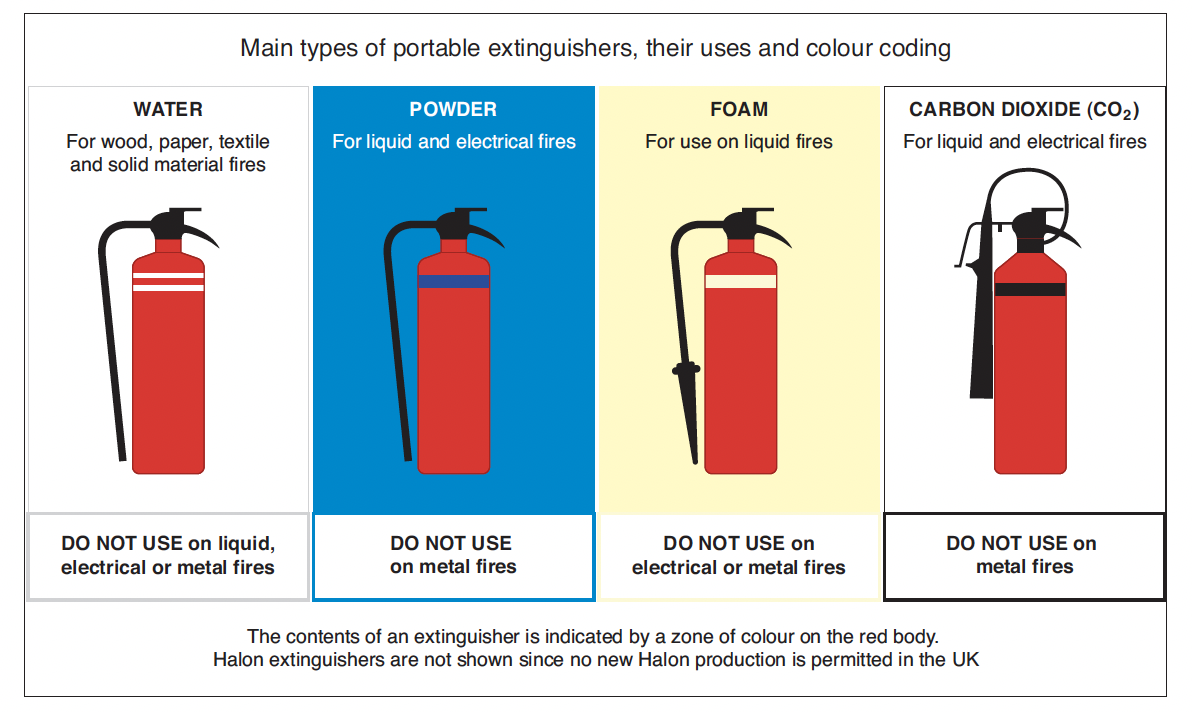Do you have the correct fire extinguishers?
Whilst carrying out fire risk assessments in Bolton and Manchester, one of the most common recommendations we make concerns appropriate portable fire fighting equipment.
Fires are classed according to what is burning. Fire extinguishers provided should be appropriate to the potential classes of fire found in your premises in accordance with Table 1.
Number and type of extinguishers
Typically for the Class A fire risk, the provision of one water-based extinguisher for approximately every 200m2 of floor space, with a minimum of two extinguishers per floor, will normally be adequate.
Where it is determined that there are additionally other classes of fire risk, the appropriate type, number and size of extinguisher should be provided. Further information is available in BS 5306-8.18
Where the fire risk is not confined to a particular location, e.g. Class A fires, the fire extinguishers should be positioned on escape routes, close to the exit from the room or floor, or the final exit from the building. Similarly, where the particular fire risk is specifically located, e.g. flammable liquids, the appropriate fire extinguisher should be near to the hazard, so located that they can be safely used.
They should be placed on a dedicated stand or hung on a wall at a convenient height so that employees can easily lift them off (at about 1m for larger extinguishers, 1.5m for smaller ones, to the level of the handle). Ideally no one should have to travel more than 30m to reach a fire extinguisher. If there is a risk of malicious use you may need to use alternative, and more secure, locations.
Consider the implications of the Manual Handling Operations Regulations 199217 when selecting and siting firefighting equipment.
In self-contained small premises, multi-purpose extinguishers which can cover a range of risks may be appropriate. Depending on the outcome of your fire risk assessment, it may be possible to reduce this to one extinguisher
in very small premises with a floor space of less than 90m2.
Extinguishers manufactured to current standards (BS EN 3-7) are predominately red but may have a colour-coded area, sited above or within the instructions, denoting the type of extinguisher. Most older extinguishers, manufactured to previous standards, have bodies painted entirely in a single colour which denotes the type of extinguisher. These older extinguishers remain acceptable until they are no longer serviceable. However, it is good practice to ensure that old and new style extinguishers are not mixed on the same floor of a building.
The following paragraphs describe the different types of extinguisherThe colour referred to is the colour of the extinguisher or the colour-coded area.
Water extinguishers (red)
This type of extinguisher can only be used on Class A fires. They allow the user to direct water onto a fire from a considerable distance. A 9-litre water extinguisher can be quite heavy and some water extinguishers with additives can achieve the same rating, although they are smaller and therefore considerably lighter. This type of extinguisher is not suitable for use on live electrical equipment.
Water extinguishers with additives (red) This type of extinguisher is suitable for Class A fires. They can also be suitable for use on Class B fires and where appropriate, this will be indicated on the extinguisher. They are generally more efficient than conventional water extinguishers.
Foam extinguishers (cream)
This type of extinguisher can be used on Class A or B fires and is particularly suited
to extinguishing liquid fires such as petrol and diesel. They should not be used on free-flowing liquid fires unless the operator has been specially trained, as these have the potential to rapidly spread the fire to adjacent material. This type of extinguisher is not suitable for deep-fat fryers or chip pans.
Powder extinguishers (blue)
This type of extinguisher can be used on most classes of fire and achieve a good ‘knock down’ of the fire. They can be used on fires involving electrical equipment but will almost certainly render that equipment useless. Because they do not cool the fire appreciably it can re-ignite. Powder extinguishers can create a loss of visibility and may affect people who have breathing problems and are not generally suitable for confined spaces.
Carbon dioxide extinguishers (black)
This type of extinguisher is particularly suitable for fires involving electrical equipment as they will extinguish a fire without causing any further damage (except in the case of some electronic equipment, e.g. computers). As with all fires involving electrical equipment, the power should be disconnected if possible.
Class ‘F’ extinguishers
This type of extinguisher is particularly suitable for kitchens with deep-fat fryers (e.g. university refectories).
Selection, installation and maintenance of portable fire extinguishers
All portable fire extinguishers will require periodic inspection, maintenance and testing. Depending on local conditions such as the likelihood of vandalism or the environment where extinguishers are located, carry out brief checks to ensure that they remain serviceable. In normal conditions a monthly check should be enough. Maintenance by a competent person should be carried out annually.
New fire extinguishers should comply with BS EN 3-7.78 Guidance on the selection and installation of fire extinguishers is given in
BS 5306-8,18 for maintenance in BS 5306-3,19 and for colour coding in BS 7863.20


